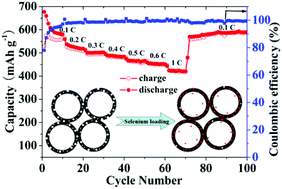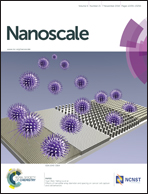Selenium/interconnected porous hollow carbon bubbles composites as the cathodes of Li–Se batteries with high performance†
Abstract
A kind of Se/C nanocomposite is fabricated by dispersing selenium in interconnected porous hollow carbon bubbles (PHCBs) via a melt-diffusion method. Such PHCBs are composed of porous hollow carbon spheres with a size of ∼70 nm and shells of ∼12 nm thickness interconnected to each other. Instrumental analysis shows that the porous shell of the PHCBs could effectively disperse and sequester most of the selenium, while the inner cavity remains hollow. When evaluated as cathode materials in a carbonate-based electrolyte for Li–Se batteries, the Se/PHCBs composites exhibit significantly excellent cycling performance and a high rate capability. Especially, the Se/PHCBs composite with an optimal content of ∼50 wt% selenium (Se50/PHCBs) displays a reversible discharge capacity of 606.3 mA h g−1 after 120 cycles at 0.1 C charge–discharge rate. As the current density increased from 0.1 to 1 C (678 mA g−1), the reversible capacity of the Se50/PHCBs composite can still reach 64% of the theoretical capacity (431.9 mA h g−1). These outstanding electrochemical features should be attributed to effective sequestration of Se in the PHCBs, as well as to the ability to accommodate volume variation and enhance the electronic transport by making Se have close contact with the carbon framework.


 Please wait while we load your content...
Please wait while we load your content...